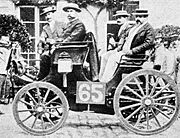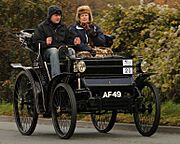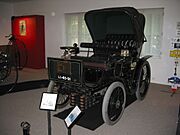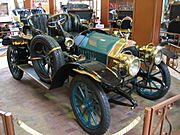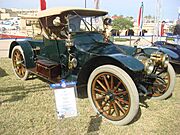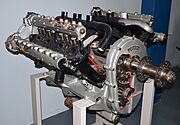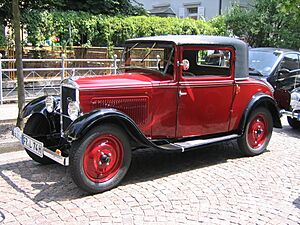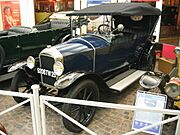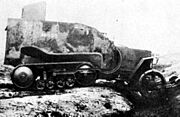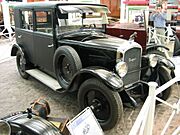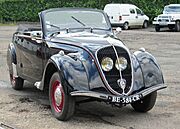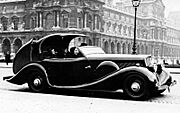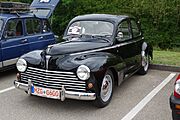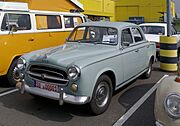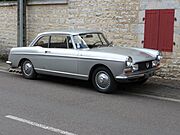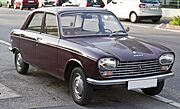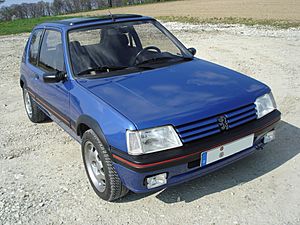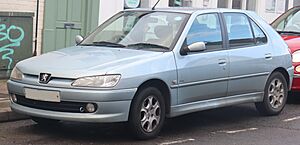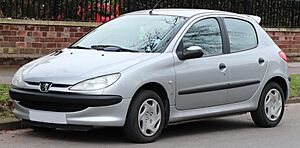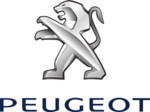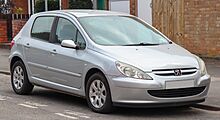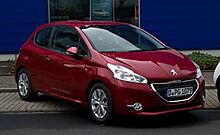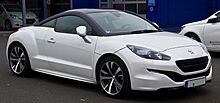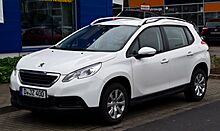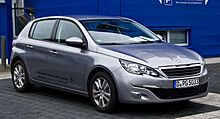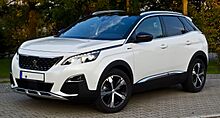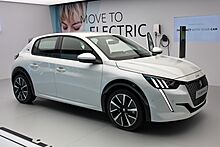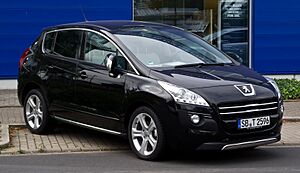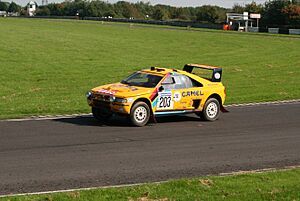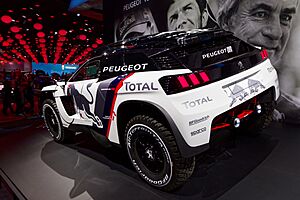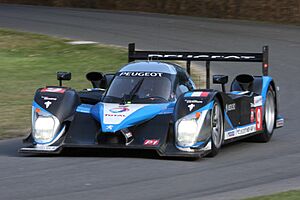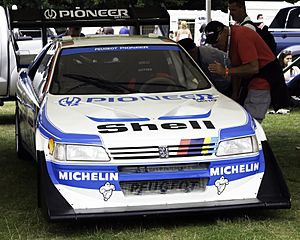Peugeot facts for kids
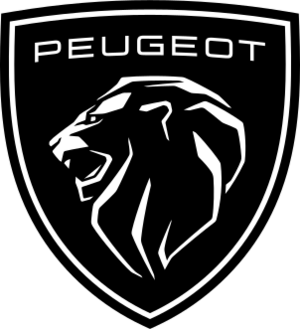 |
|
| Subsidiary | |
| Industry | Automotive |
| Fate | Merged with Citroën in 1976 to form the PSA Group |
| Founded | 26 September 1810 |
| Founder | Armand Peugeot (who incorporated the automotive company in 1896) |
| Headquarters | Legal and top level administrative: Poissy (new); Ave. de la Grande Armée, Paris (old) Operational: Sochaux, France |
|
Area served
|
Worldwide (except the U.S., Canada and North Korea) |
|
Key people
|
Alain Favey (CEO) |
| Products |
|
|
Production output
|
|
| Parent | Stellantis |
| Divisions | Peugeot Sport Cycles Peugeot (formerly) |
Peugeot is a French car company that is part of Stellantis. The Peugeot family started their business way back in 1810, making them one of the oldest companies involved in vehicles. In 1858, Émile Peugeot created the famous lion logo. Armand Peugeot built the company's first vehicle, a steam-powered tricycle, in 1886. Later, in 1890, they made a car with a petrol engine.
The Peugeot family and company come from Sochaux, France. Today, Peugeot still has a big factory and a museum there.
Peugeot cars have won many awards, including six European Car of the Year awards. The brand also has a long history of success in car racing, winning races like the Indianapolis 500 and the Dakar Rally.
Contents
History of Peugeot Cars
Starting with Tools and Bikes
The Peugeot family began their manufacturing business in 1810 in France. They first made steel products like saws and hand tools. Around 1840, they started making coffee grinders, then pepper grinders, and by 1880, bicycles. Their journey into vehicles began with steel rods used in clothing, which led to making umbrella frames, wire wheels, and bicycles. Armand Peugeot introduced his "Le Grand Bi" penny-farthing bicycle in 1882.
The company's first logo, a lion walking on an arrow, showed how fast, strong, and flexible Peugeot's saw blades were. The car and motorcycle parts of the company separated from the bicycle business in 1926. However, the family-owned Cycles Peugeot kept making bicycles for many years. The family firm Peugeot Saveurs still makes kitchen tools today.
First Cars and Early Races
Armand Peugeot was very interested in cars. After meeting with Gottlieb Daimler, he was sure cars had a future. Peugeot's first car was a three-wheeled, steam-powered vehicle made in 1889. Only four were built. Steam cars were heavy and took a long time to warm up. So, in 1890, Peugeot switched to a four-wheeled car with a petrol engine. This car was quite advanced for its time.
More cars were built each year. By 1899, Peugeot had made 300 cars. Peugeot was the first car maker to use solid rubber tires on a petrol car. Because of family disagreements, Armand Peugeot started his own car company in 1896, but it later rejoined the family's bicycle and motorcycle business in 1910.
Peugeot was one of the first companies to get into car racing. Albert Lemaître won the world's first car race, the Paris–Rouen, in a 3 horsepower Peugeot in 1894. In 1896, Peugeot started building its own engines, so they didn't need Daimler's anymore. These new engines were more powerful.
In 1901, Peugeot introduced a small, one-cylinder car called "Bébé" (meaning "baby"). This car helped Peugeot become a leader in car style. Peugeot also started making motorcycles in 1901. By 1903, Peugeot made half of all cars built in France.
A famous car designer, Ettore Bugatti, designed a new "Bébé" car in 1912. That same year, Peugeot returned to racing with a special team of engineers and drivers. They built a very advanced racing engine with four valves per cylinder, which was much faster than other cars. Georges Boillot won the 1912 French Grand Prix with this car. In 1913, Jules Goux won the Indianapolis 500 race in a Peugeot, making Peugeot the first non-American company to win there.
During World War I, Peugeot mostly made weapons and military vehicles, like armored cars and aircraft engines.
Between the World Wars
After World War I, car production started again. Peugeot continued racing and won several important races in the 1920s. In 1926, the bicycle and motorcycle business split off to form Cycles Peugeot.
In 1929, Peugeot introduced the Peugeot 201, which was the cheapest car in France. It was also the first car to use Peugeot's famous three-digit naming system with a zero in the middle (like 201, 301, etc.). The first digit shows the car's size, and the last digit shows its generation. The 201 helped Peugeot survive the Great Depression.
In 1934, Peugeot introduced the 402 BL Éclipse Décapotable, which was the first convertible car with a retractable hardtop (a roof that folds into the car's body). This was a very innovative idea!
Cars like the Peugeot 202, Peugeot 302, and Peugeot 402 from the 1930s had smooth, curved designs. The 202 was built from 1938 to 1942 and helped Peugeot's sales grow.
After World War II
In 1946, Peugeot started making cars again with the 202. In 1947, they introduced the Peugeot 203, which had new features like coil springs and hydraulic brakes. The 203 was very popular and sold many cars.
In 1955, the Peugeot 403 was released and sold over a million copies. Peugeot started selling cars in the United States in 1958. In 1960, the Peugeot 404 came out and was tough enough to win the East African Safari Rally four times.
Many later Peugeot models, like the Peugeot 504, were designed by the famous Italian design firm Pininfarina. Peugeot also started working with other car companies like Renault and Volvo to develop new engines.
Joining Forces with Other Companies
In 1974, Peugeot bought a part of Citroën, and by 1975, they owned the whole company. Citroën was having money problems because they developed too many new car models. The two companies formed the PSA Peugeot Citroën group. They wanted to keep Peugeot and Citroën cars looking different but share engineering and technical parts.
Later, in 1978, the group bought the European part of Chrysler, which included the brands Rootes and Simca. These cars were then sold under the old Talbot name until 1987.
The 1980s and 1990s
In 1983, Peugeot launched the very successful Peugeot 205 small car. This car helped the company's finances greatly. The 205 was often the best-selling car in France and was popular across Europe. It was praised for its style and how it drove. The 205 was sold until 1998, overlapping with the Peugeot 106 and later the Peugeot 206, which became Peugeot's best-selling model ever.
By 1987, Peugeot stopped using the Talbot brand for passenger cars. The Talbot Arizona car became the Peugeot 309. This car was built in factories in Britain and France. The 309 was the first Peugeot hatchback of its size and sold well. Its replacement, the Peugeot 306, was also very popular.
The Peugeot 405 sedan was launched in 1987 and was voted European Car of the Year. It was also very popular in Europe. Peugeot stopped selling cars in the United States and Canada in the early 1990s because sales were too low.
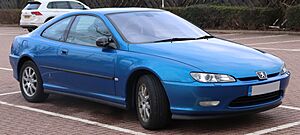
In 1997, Peugeot returned to Mexico after many years.
2000s to Today
In 2006, Peugeot announced they would close their factory in Coventry, England, which led to job losses. The factory closed in 2007.
Peugeot aimed to sell 4 million cars a year by 2010, but sales remained below 2 million. In 2009, Peugeot started selling scooters in Canada again.
By 2010, Peugeot planned to expand into new markets like China, Russia, and South America. In 2011, they decided to re-enter India.
In 2012, General Motors bought a small share in Peugeot to work together, but GM sold its share in 2013. In 2013, Peugeot closed a factory in France as part of a plan to reduce costs. In 2014, the Peugeot family agreed to share control of the company with Dongfeng Motors (a Chinese company) and the French government. This created three main partners.
In 2015, the Indian company Mahindra & Mahindra bought a large part of Peugeot Motocycles (the motorcycle division). Also in 2015, Peugeot España was fined in Spain for working with other car companies to control prices.
In 2020, it was announced that Peugeot's parent company, PSA, would merge with Fiat Chrysler Automobiles (FCA). This merger was completed in January 2021, and the new combined company is called Stellantis.
Peugeot Factories
Peugeot cars are made in many factories around the world, both by Stellantis and through partnerships with other companies.
Stellantis Plants
- France: Poissy (makes DS 3 Crossback), Mulhouse (makes Peugeot 2008, Peugeot 508), Sochaux (makes Peugeot 308, Peugeot 3008, Peugeot 5008), Rennes (makes Peugeot 508, Peugeot 5008)
- Algeria: Oran (makes Peugeot 208)
- Argentina: Buenos Aires (makes 208, 308, 408)
- Brazil: Porto Real (makes Peugeot 208, Peugeot 2008)
- Portugal: Mangualde (makes Peugeot Partner)
- Slovakia: Trnava (makes Peugeot 208)
- Spain: Madrid (makes 207 Plus, 207 CC), Vigo (makes Peugeot Partner, Peugeot 301)
Joint Venture and Partner Plants
- Austria: Graz (makes Peugeot RCZ)
- China: Wuhan (makes 206 Plus, 307, 308, 408, 508)
- Czech Republic: Kolín (makes Peugeot 107, Peugeot 108)
- Iran: Tehran (makes 206, 206 Sedan, 207i, 405, 208, 2008, 301, 508)
- Italy: Atessa (makes Peugeot Boxer)
- Japan: Mizushima (makes Peugeot iOn)
- Malaysia: Gurun (makes 208, 2008, 308, 408, 508, 5008)
- Russia: Kaluga (makes Peugeot 4007, Peugeot 308)
- Turkey: Bursa (makes Peugeot Bipper)
- Vietnam: Ho Chi Minh City (makes Peugeot 408)
- Pakistan: Karachi (makes Peugeot 2008)
Peugeot Vehicles
Car Awards and Recognition
Peugeot cars have won many awards over the years:
European Car of the Year
Peugeot has won this important award six times:
- 1969 – Peugeot 504
- 1988 – Peugeot 405
- 2002 – Peugeot 307
- 2014 – Peugeot 308
- 2017 – Peugeot 3008
- 2020 – Peugeot 208
Other Awards
- Women's World Car Of The Year
- 2022 - Peugeot 308
- Semperit Irish Car of the Year award
- 1997 – Peugeot 406
- 2010 – Peugeot 3008
- Car of the Year award in Italy
- 2007 – Peugeot 207
- 2010 – Peugeot 3008
- 2013 – Peugeot 208
- 2014 – Peugeot 2008
- 2015 – Peugeot 308
- Car of the Year award in Spain
- 1981 – Talbot Horizon
- 1985 – Peugeot 205
- 1999 – Peugeot 206
- 2002 – Peugeot 307
- 2005 – Peugeot 407
- 2006 – Peugeot 1007
- 2007 – Peugeot 207
- 2012 – Peugeot 508
- 2013 – Peugeot 208
- Best Used Small Car of the Year
- 2022 – Peugeot 208
- Best-Selling Car in Europe
- 2022 – Peugeot 208
Peugeot Car Series
Peugeot uses a numbering system for its cars, like 100-Series, 200-Series, and so on. The middle zero is a Peugeot trademark.
- 100-Series: Peugeot 104, Peugeot 106, Peugeot 107, Peugeot 108
- 200-Series: Peugeot 201, Peugeot 202, Peugeot 203, Peugeot 204, Peugeot 205, Peugeot 206, Peugeot 207, Peugeot 208
- 300-Series: 301 (Original), Peugeot 302, Peugeot 304, Peugeot 305, Peugeot 309, Peugeot 306, Peugeot 307, Peugeot 308, Peugeot 301
- 400-Series: Peugeot 401, Peugeot 402, Peugeot 403, Peugeot 404, Peugeot 405, Peugeot 406, Peugeot 407, 408
- 500-Series: Peugeot 504, Peugeot 505, Peugeot 508
- 600-Series: Peugeot 601, Peugeot 604, Peugeot 605, Peugeot 607
- 800-Series: Peugeot 806, Peugeot 807
- 900-Series: Peugeot 905, Peugeot 908, Peugeot 9X8
- 1000-Series: Peugeot 1007
- 2000-Series: Peugeot 2008
- 3000-Series: Peugeot 3008
- 4000-Series: Peugeot 4007, Peugeot 4008, 4008 (China)
- 5000-Series: Peugeot 5008
Electric and Hybrid Cars
Peugeot has been working on electric and hybrid cars. In 2008, they showed a concept hybrid sports car called the Peugeot RC HYmotion4. In 2010, Peugeot started selling the electric Peugeot iOn, which was based on a Mitsubishi car.
Peugeot aims for all its models to have an electric version by 2025. By 2030, they expect all Peugeots sold in Europe to be electric. This is part of their goal to create more sustainable and eco-friendly transport.
Peugeot in Motorsport
Early Racing Success
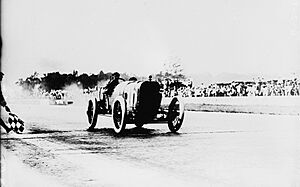
Peugeot has been involved in racing since the very beginning. In 1894, a Peugeot car won the first motor race, the Paris-Rouen Trials. In 1912, a Peugeot car with a revolutionary engine won the French Grand Prix. This engine design, with its special camshafts and valves, was very important for future racing engines.
In 1913, Peugeot cars won both the French Grand Prix and the Indianapolis 500. This made Peugeot the first non-American car company to win at Indianapolis.
Rallying Achievements
Peugeot Sport is very successful in rallying. They have won the World Rally Championship five times (1985, 1986, 2000, 2001, 2002) and the Dakar Rally seven times (1987, 1988, 1989, 1990, 2016, 2017, 2018).
In the 1960s, Peugeot cars had great success in the East African Safari Rally. In the 1980s, Peugeot entered the World Rally Championship with the powerful Peugeot 205 Turbo 16. This car was very dominant, winning championships in 1985 and 1986.
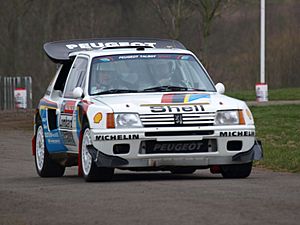
After Group B cars were banned in 1987, Peugeot switched to rally raids like the Dakar Rally. They won the Dakar Rally four times in a row from 1987 to 1990. Peugeot returned to the Dakar Rally in 2015 and won again in 2016, 2017, and 2018 with their new 2008 DKR and 3008 DKR cars.
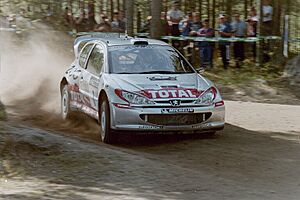
In 1999, Peugeot returned to the World Rally Championship with the Peugeot 206 WRC. This car was very competitive and helped Peugeot win the manufacturers' title in 2000, 2001, and 2002.
Touring Car Racing
Peugeot has also had success in touring car races. In 2013, the Peugeot 208GTi won the 24 Hours Nürburgring endurance race. The Peugeot 306 GTi won the Spa 24 hours endurance race in 1999 and 2000. Peugeot cars have also won championships in Asian, Danish, and Brazilian touring car series.
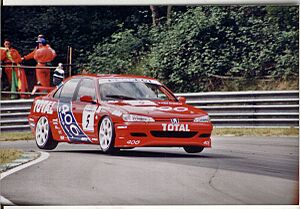
Sports Car Racing
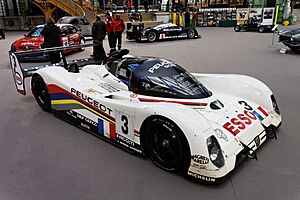
In the 1990s, Peugeot competed in endurance racing with the Peugeot 905. This car was very successful, winning the World Sportscar Championship in 1992 and the 24 Hours of Le Mans in 1992 and 1993.
Peugeot returned to Le Mans in 2007 with the diesel-powered Peugeot 908 HDi FAP. After some challenges, the Peugeot 908 HDi FAPs finished first and second at the 2009 24 Hours of Le Mans.
Pikes Peak Hillclimb
In 2013, a special Peugeot 208 T16 car, driven by Sébastien Loeb, broke the record at the Pikes Peak International Hill Climb. This car was very light and had a powerful twin-turbo V6 engine. It finished the race in an amazing 8 minutes and 13.878 seconds.
Concept Cars
Peugeot often creates "concept cars" to show off new ideas and designs for the future. Some of these include:
- Peugeot Quasar (1984)
- Peugeot Proxima (1986)
- Peugeot Oxia (1988)
- Peugeot Ion (1994)
- Peugeot Touareg (1996)
- Peugeot Asphalte (1996)
- Peugeot 806 Runabout (1997)
- Peugeot 206 (1998)
- Peugeot 206 Escapade (1998)
- Peugeot Les City Toyz (2000)
- Peugeot 607 Feline (2000)
- Peugeot 607 Paladine (2000)
- Peugeot Sésame (2002)
- Peugeot 607 Pescarolo (2002)
- Peugeot 307 CC (2002)
- Peugeot H2O (2002)
- Peugeot RC (2002)
- Peugeot Hoggar (2003)
- Peugeot 407 Elixir (2003)
- Peugeot 4002 (2003)
- Peugeot 407 Silhouette (2004)
- Peugeot Quark (2004)
- Peugeot 907 (2004)
- Peugeot Coupé 407 Prologue (2005)
- Peugeot 20Cup (2005)
- Peugeot 908 RC (2006)
- Spider 207 (2006)
- Peugeot RC HYbrid4 HYmotion4 (2008)
- Peugeot RD (2008)
- Peugeot BB1 (2009)
- Peugeot EX1 Concept (2010)
- Peugeot HR1 (2010)
- Peugeot SR1 (2010)
- Peugeot 5 by Peugeot (2010)
- Peugeot HX1 (2011)
- Peugeot SXC (2011)
- Peugeot Onyx (2012)
- Peugeot Exalt (2014)
- Peugeot Quartz (2014)
- Peugeot Fractal (2015)
- Peugeot Instinct (2017)
- Peugeot e-Legend (2018)
- Peugeot Inception (2023)
Peugeot Dealerships
Peugeot has special flagship dealerships called Peugeot Avenue. These used to be in famous places like the Champs-Élysées in Paris and in Berlin. They showed off both regular cars and cool concept cars.
Peugeot Motorcycles and Scooters
The Peugeot Motocycles company still makes many scooters, underbones, and mopeds in Europe. They also made an electric scooter called the Scoot'Elec from 1996 to 2006.
Peugeot Bicycles
Peugeot started making bicycles in 1882. Peugeot bicycles have won the Tour de France ten times between 1903 and 1983. The Peugeot bicycle brand is still part of the Cycleurope S.A. company today.
Kitchen Equipment
A separate company owned by the Peugeot family, called Peugeot Saveurs, still makes kitchen and table tools. This includes pepper grinders, salt grinders, corkscrews, and cutlery.
See also
 In Spanish: Peugeot para niños
In Spanish: Peugeot para niños
- List of automobile manufacturers of France
- French bicycle industry
- List of automobile manufacturers
- List of companies of France
- Peugeot Concours Design



